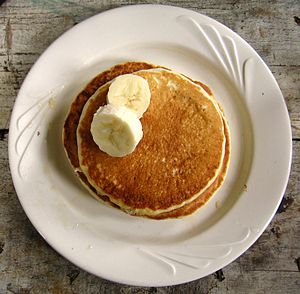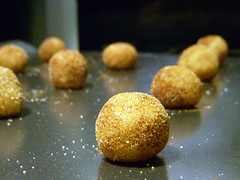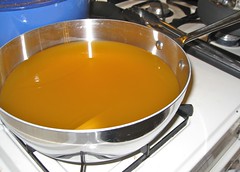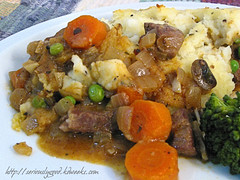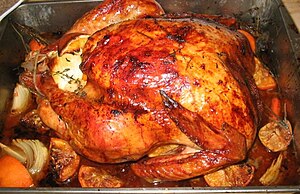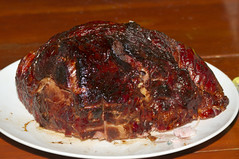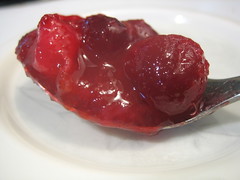After a short break for the (meat-filled) Thanksgiving holiday, I'm back with the final part and reason for my meat-eating lifestyle. If you missed
Parts 1 and
2, you may want to check them out and catch up before reading this post.
So let's just dive right in, and you can yell at me later, but regardless of your position on eating meat, this reason is the one that is the most irrefutable....
Reason #3: It's Unnatural
As I dive into this one I may get a little bit religious to start with, but bear with me.... I happen to be a Christian (not born and raised, but born again, so to speak), and the more I learn about health, nutrition, and God, the more I realize that there is a simple and basic truth that would solve so many of the health problems we face today as a nation - and it's a truth that any Christian would find to be self-evident when given a bit of thought.
|
|
| Ancient travelers with their meat "on the hoof." (Photo credit: Wikipedia) |
That truth is:
God made everything we need to be healthy. It is when we stray from the God-given foods that problems occur - which makes sense, as He made our bodies, so obviously He would know what they are supposed to eat! When we try to play God and create foods for ourselves, there's just no way we are going to match what He made for us. There are so many conflicting opinions out there when it comes to good nutrition, many people are very confused. But for me it is
very simple. I have two main statutes that guide what I eat and what I suggest to others when they ask me for food advice.
1. Eat what God made. I hear the arguments already: "God made everything, so how does this help?" Not so fast, my logical friend.... God DID make everything, in that He made all of the elements that all things are made of. However, God did NOT make some of these crazy concoctions that we put together for ourselves and add to our food. God did not make artificial food dyes, artificial flavorings (which try to copy what God actually DID make, and usually fail entirely), sweeteners, etc. These things are not natural substances, and our bodies were not designed to process them - and THAT is a scientific fact. Yes, God may have made most of the ingredients in a Cheeto, but that doesn't mean it's good for you - which brings me to rule #2....
2. Eat it the way God made it. Again, He knew what He was doing when He made us, and the foods we are to eat. Now, if you've read the book of Genesis, you may pose the argument - what about when it says that God "made the plants and seeds of the earth" for our food? As to this, I will not dive any further into theology, but I will just say that in terms of spiritual connection and peace, it would make sense not to eat our fellow animals, but then again indeed we live in a fallen world, and people did eat meat throughout the rest of the Old Testament. Either way, there is no denying the fact that the majority of things that we eat besides meat in our modern world are much less natural for our bodies to ingest. You simply cannot tell me that your "tofurky" patty made of soybeans, hydrogenated oils, and 20 other ingredients that have been processed 10 ways to Sunday to make it palatable and somewhat resembling meat (see
Reason #2) is anywhere near as natural and easy for our bodies to process as a simple steak. It's just
not. And maybe,when you really think about it, any "food" that has to be processed that much just to be edible isn't even something we should be eating anyway.... Right?!? (Take that you proponents of tofu!) :-)
Okay, moving on from religion now (I hear the sigh of relief).... There are more reasons besides the theological/health one, why I don't think a diet completely devoid of animal products is natural - not just for humans, but for the planet as a whole. (Wow, from Christianity to environmentalism? I know - this one's a doozy, right? I'm still expecting to get yelled at from some quarter any minute now....) :-)
But if you look at the planet as a whole - and again, going back to God for just one second here - it was created as a symbiotic ecosystem - everything works together for the good of the whole. When it comes to growing crops, we currently are stripping our soils and polluting our waters to produce more food on a limited amount of land. To do this, we have resorted to chemical fertilizers based on fossil fuels (again - a limited resource). We are only starting to see the impact of this on our health and the health of the planet as a whole, but so far the results of this experiment are not looking good....
|
|
| Jacob sheep on pasture. (Photo credit: Wikipedia) |
Removing animals from the equation entirely can only make the problem worse. Animal outputs (manure, etc.) are one of the best natural forms of fertilizer that exists. And incorporating these natural materials into growing our plant foods is essential if we want to maintain a healthy planet for future generations. Just for a second envision if the entire human race were to go to an entirely plant-derived diet.... This would mean clearing massive amounts of land to grow more and more grains and plant foods, but what about the animals?? Where would animals (and their natural fertilizer outputs) fit into a world where no one ate meat, milk, eggs, etc.? This is such an unbalanced and unnatural system - there is just
no way it is sustainable long term. Plants feed animals, which in turn feed plants, which in turn feed us, but if you take away the animals (or severely limit their presence in the natural ecosystem), the whole thing falls apart.*
Besides our health, and the health of our planet, I do have one more final note as to why veganism isn't natural - and it goes back to history. In the history of our species as we know it, never has there been discovered a single vegan culture that we know of. They just don't exist. There are some modern cultures that limit the eating of meat (as far as I know, they do still consume some in the instance of fish and poultry), but even these are newer traditions, and regardless, they do still eat some animal products, even when avoiding flesh. And we've yet to see how these people fare long-term on these types of diets - so far it's a short-term experiment.
So there you have it - why I'm not a vegan. My reasons are based on science, theology, and history - and most of all, health. Real health is based on moderation and balance. Eliminating one food group entirely is is the opposite of these things. Cutting out some of the best and most available sources of protein, fats, and fat-soluble vitamins, in favor of scrambling to create artificial and largely inadequate substitutes, simply makes no sense in a holistically balanced life.*
* Caveat: I am entirely on board with the fact that conventionally farmed meats are raised in largely unhealthy and unnatural environments. I do my best not to eat these meats, and I don't suggest that you do either. Finding sources of clean, fresh, naturally and humanely raised animal products is essential if you are going to consume these products on a regular basis - essential for both your health, and the health of the planet as a whole. I do have some helpful tips and resources for this on my website: http://www.newholisticliving.com/csa.html.
I hope you've enjoyed this short series, and that you've found it enlightening and perhaps helpful in restoring your peace of mind and enjoyment of what you eat - even if you eat meat and animal products. As stated in
Part 1, if you choose to follow a vegan diet, that is up to you, and I encourage you to do what feels best for your body and health. But please do listen to your body, and if it needs things a plant-derived diet simply can't provide, don't beat yourself up over eating the natural whole foods you need, even if they happen to contain meat.
And if you wish to research further for yourself, I've found the books below to be quite helpful.
Happy eating!





